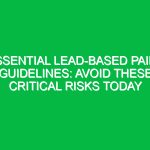“`html
Essential Lead (Pb) Guidelines: Avoid These Critical Health Risks
Good morning team,
Today, we’re discussing a crucial topic that directly impacts our health and Safety at work: Lead (Pb) exposure. Understanding the essential lead guidelines is vital for avoiding serious health risks associated with lead. This discussion is not just about compliance; it’s about ensuring that we all can work safely and effectively every day.
Understanding Lead (Pb)
Lead is a toxic metal that has been used in various industries for centuries, from construction to manufacturing. Despite its beneficial properties, such as corrosion resistance and malleability, it poses significant health risks. Lead exposure can occur through inhalation, ingestion, or skin contact, making it essential to understand its dangers and implement strict Safety Measures.
Common misconceptions about lead exposure include the belief that low levels are harmless. In reality, even small amounts of lead can accumulate in the body over time, leading to serious health issues, including:
- Cognitive impairment
- Kidney damage
- Reproductive problems
- High blood pressure
Key Hazards, Risks, and Safety Considerations
Lead exposure can occur in various workplace settings. Some of the most common sources include:
- Lead-based paints, especially in older buildings
- Metal manufacturing and recycling
- Construction work involving lead pipes or solder
- Battery manufacturing and recycling
Ignoring safety protocols related to lead exposure can lead to severe consequences, not only for your health but also for your ability to work. For instance, prolonged exposure can result in lead poisoning, which may require medical intervention and can lead to long-term health complications.
Best Practices, Procedures, & Actionable Advice
To ensure a safe working Environment, everyone must adhere to the following essential lead guidelines:
1. Personal Protective Equipment (PPE)
Always wear appropriate PPE when working in environments with potential lead exposure. This includes gloves, respirators, and protective clothing. Ensure that your PPE is well-maintained and fits correctly.
2. Hygiene Practices
Implement strict hygiene practices to minimize lead exposure. Always wash your hands before eating, drinking, or smoking, and use designated break areas away from lead work zones.
3. Proper Ventilation
Ensure that work areas are adequately ventilated. This helps to minimize inhalation of lead dust. Use local exhaust ventilation systems where necessary to control airborne lead levels.
4. Regular Monitoring
Participate in regular monitoring of lead levels in your work environment. This includes air sampling and testing for lead in blood. Reporting any concerns immediately is crucial for maintaining safety.
5. Training and Awareness
Attend all Training sessions on lead safety. Understanding the risks and safe handling Procedures will empower you to protect yourself and your colleagues effectively.
Case Study: Lead Exposure in the Workplace
Consider the case of a manufacturing facility where employees were not provided adequate PPE while handling lead materials. Over time, several employees exhibited symptoms of lead poisoning, which led to costly medical expenses and lost workdays. This situation could have been avoided by implementing proper Safety Measures and training.
Regulations, Standards, and Compliance
Compliance with safety Standards is not just a regulatory requirement but a moral obligation to protect your health. OSHA (Occupational Safety and Health Administration) has established strict guidelines for lead exposure in the workplace, which include:
- Permissible exposure limits (PELs) for lead
- Requirements for monitoring lead levels
- Medical surveillance for employees exposed to lead
Adhering to these Regulations is crucial for minimizing risks and ensuring a safe workplace. Non-compliance can lead to severe penalties and increased exposure risks for employees.
Employee Engagement & Discussion
Now, I’d like to hear from you. What safety challenges have you encountered related to lead exposure in your work? Are there any additional measures you think we should implement to enhance our safety protocols?
Sharing your experiences can help us all learn and improve our practices.
Conclusion & Key Takeaways
In summary, understanding and following essential lead (Pb) guidelines is critical for protecting our health and safety at work. Remember the importance of:
- Wearing appropriate PPE
- Practicing good hygiene
- Ensuring proper ventilation
- Participating in regular monitoring
- Staying informed through training
Let’s commit to applying these practices daily to create a safer work environment for ourselves and our colleagues. Thank you for your attention and your commitment to safety!
“`


